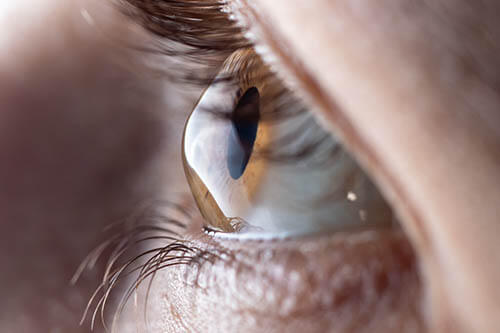
Do you or someone you love have keratoconus? You may be a good candidate for a revolutionary treatment called corneal cross-linking offered at Dell Laser Consultants. Dr. Dell was the first surgeon in Austin to offer this technology and served as the chairman of the first national meeting on corneal cross-linking in the US.
What is Keratoconus?
Keratoconus is a progressive eye condition that causes the cornea to become too thin and bulge. It causes the cornea to bow forward abnormally, causing blurred vision.
As the cornea becomes thinner, it will bulge outward, resembling a cone. When this happens, the cornea becomes irregularly shaped, impairing vision.
It is a fairly common condition, affecting about 1 in 400 people. Keratoconus tends to run in families, and there is a strong correlation between eye rubbing and eye allergies.
Children can sometimes be affected, and their vision can deteriorate very rapidly. It is particularly critical to treat children with keratoconus promptly once the diagnosis is made.
What Causes Keratoconus?
Though the exact cause of keratoconus is still unknown, the cause stems from a combination of environmental factors and being passed down as a hereditary condition. Two of the most established risk factors of the eye condition are having a family history of keratoconus and rubbing of the eyes.
These factors lead to structural changes and thinning of the cornea.
Who is Most Likely to Develop Keratoconus?
Although anyone can develop keratoconus, you’re most likely to develop the eye condition if:
You Have a Family History of Keratoconus
Knowing you have a family member, like a sister, brother, or parent, with keratoconus dramatically increases your risk of developing keratoconus. Make sure to tell your ophthalmologist so they can monitor your eyes for any early signs of the eye condition.
You’re a Teenager or Young Adult
Keratoconus usually develops in patients in their teens or around their early twenties or thirties. After this age range, rates decline quickly.
You Have Certain Medical Conditions
If you have certain medical conditions like Ehlers-Danlos syndrome, Down syndrome, Marfan syndrome, hay fever, or asthma, these can increase your risk of developing keratoconus.
If you believe you’re at an increased risk of developing keratoconus, it’s essential to tell your eye doctor so they can monitor your eyes for any signs of the eye condition.
How Often Should You Have Your Eyes Checked for Conditions Like Keratoconus?
If you’re concerned about keratoconus, you should have annual eye exams conducted starting in your teenage years. Annual eye exams at this age can help spot any early changes to the eyes due to keratoconus.
If you or a loved one are diagnosed with keratoconus, eye exams will be needed every 6-12 months. These eye exams will allow your ophthalmologist to assess the progression of the eye condition. They will also enable them to adapt treatment and make changes if necessary.
Does Keratoconus Have Any Symptoms?
If you have keratoconus, common symptoms include:
Blurry Vision

As the cornea becomes thinner and continues bulging out as the condition progresses, vision becomes more distorted. Patients with keratoconus will notice a loss of sharp, clear vision, noting that everything looks blurry instead.
This will be the case even if they wear glasses and contact lenses. Blurry vision is often one of the first symptoms patients with keratoconus notice or experience.
Light Sensitivity and Glare
As the cornea continues changing its shape in patients with keratoconus, another symptom patients may notice is increased light sensitivity and glare, along with halos. These can make driving far more challenging at night due to streetlights and lights from oncoming traffic.
More Frequent Prescription Changes
Patients will likely need more frequent changes in their glasses and contact lenses prescription as keratoconus progresses.
How Do You Treat Keratoconus?
Because keratoconus is a progressive eye condition, treating it requires management. Treatment options for keratoconus include:
Rigid Gas Permeable Contact Lenses
Rigid gas permeable (RGP) contact lenses are specially designed for patients with keratoconus. These contact lenses create a smooth optical surface over the cornea’s irregular shape due to keratoconus.
Intracorneal Ring Segments
Intracorneal ring segments are small segments implanted in the cornea to flatten its cone shape temporarily. This helps improve vision and symptoms associated with keratoconus.
Corneal Transplant
Advanced cases of keratoconus may require a corneal transplant when the cornea becomes dangerously thin or if sufficient visual acuity is no longer possible due to steepening, contact lens intolerance, or corneal scarring. This may require a full or partial corneal transplant to remove diseased corneal tissue to improve vision.
Is Keratoconus Hereditary?
Yes, keratoconus can be hereditary. If you have a close family member, like a parent, sibling, or grandparent, who has keratoconus, your risk of developing the eye condition increases.
However, genetics is not the only reason you could develop keratoconus. Environmental factors can also play an essential role.
Your risk of developing keratoconus may increase due to environmental factors like:
- Chronic eye rubbing, which puts stress on the cornea and can weaken its structures over time
- Excessive exposure to UV light without proper protection from the sun’s rays
- Irritation from contact lenses due to contact lenses that don’t fit properly on the irregularly shaped cornea
- Eye allergies may lead to an increased risk of rubbing the eyes and further irritation
- Physical trauma or injury due to activities like rubbing, poking, or scratching your eye may lead to thinning of the cornea, weakening it and eventually leading to keratoconus
- Exposure to environmental pollutants like cigarette smoke and pollution may promote oxidative damage to corneal collagen, leading to potential thinning of the cornea
If you believe you’re at an increased risk for developing a condition like keratoconus, inform your eye doctor. Early diagnosis and treatment are crucial to ensuring the management of the eye condition.
Is There a Cure for Keratoconus?
Although there are treatment options for keratoconus, like corneal cross-linking, these can only manage the eye condition. There is no way to cure keratoconus.
However, with early diagnosis and management with rigid gas-permeable contact lenses as well as other treatments like corneal cross-linking, it’s possible to slow down the progression of keratoconus. Slowing down the progression of keratoconus means maintaining good vision in patients and ensuring they can live a good quality of life.
Frequently Asked Questions About Corneal Cross-Linking
Do you have additional questions about corneal collagen cross-linking in Austin? Schedule an appointment with one of the experienced eye doctors at Dell Laser Consultants in Austin, TX, today!
Want to Learn More
Interested in Corneal Cross-Linking? Click the button below to contact us!





